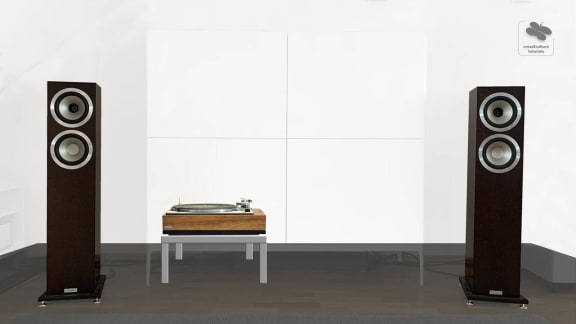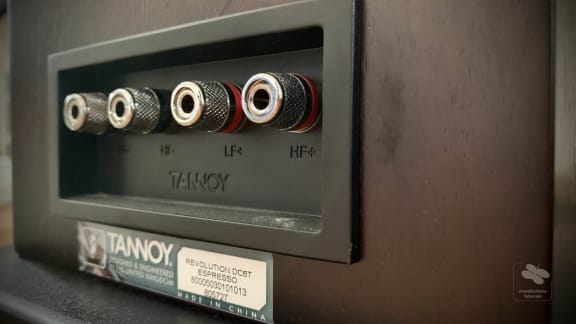Tannoy DC6T
Published: 05/06/2020
Manufacturing date: 2010
Author: Karsten Hein
Category: Gear & Review
Tag(s): Loudspeakers
It may not be immediately obvious from looking at the photos, but I had to think long and hard about how and if to present loudspeakers on this platform. For one thing, loudspeakers are vertical objects, whereas I have made a point in maintaining a 16:9 horizontal picture format in my presentations. Secondly, it was clear from the start that I would not be able to offer a look inside the speakers, for the simple reason that this might cause damage to the cabinet or drivers and thereby lower the resale value – a significant consideration, if I want to continue our Explorations in Audio on a reasonable budget. And, lastly, loudspeaker performance depends to a great extent on the environment in which the speakers are placed.
I finally decided that, due to the significant role speakers play in our systems, I would double-layer my photos based on the current listening environment that the speakers are in and to fade out the room features. My intention in doing so was to lessen the prominence of the room and to thereby give you the opportunity of imagining the same speakers placed in your own environment. The advantage is that you see the speakers at the toe-in angle and distance that is most realistic to real life.
Tannoy was founded by Guy Fountain as the Tulsemere Manufacturing Company in England in 1926 and ranks among the oldest manufacturers of loudspeakers in the world. The name is an abbreviation of ‘tantalum alloy’ a material that was used in electrolytic rectifiers that were developed by the company. The Tannoy trademark was registered in 1932. With its original headquarters in London, Tannoy soon became famous as a manufacturer of public address speakers and professional speakers for the military in World War II. Since the name was shown in bold letters on the speaker grills and thereby frequently visible to the general public, to ‘Tannoy’ an event became synonymous with providing amplification for it. In fact, older Englishmen can still be heard referring to public address systems as Tannoys, despite the fact that, more often than not, these systems today come from a wide range of manufacturers.
Following economic pressures, Tannoy moved to Coatbridge, Scotland in the 1970s, where it has remained. Today, the company belongs to the Uli Behringer MUSIC Group, that has pledged to preserve the brand and to keep the Scottish location. In recent years, with mainstream buyers turning away from High Fidelity for the sake of cheap USB & wireless gadgets, Tannoy has been struggling to keep their foothold. Tannoy did not invent coaxial driver designs, but they certainly were among the pioneers of this technology. The Tannoy signature Dual Concentric driver was invented in 1948. It boasted a design in which the tweeter was set deeply inside the center of the woofer. The on-axis position had the advantage of improved time and phase alignment and was originally intended for microphone measurements. The original pair ended up being used in Decca’s FFRR studios, and then EMI ordered some for Abbey Road (source: whathifi.com), a studio made famous by The Beatles, among others. Form there it was only a short way to stardom.
The Tannoy DC6t of 2010 comes in a slender modern design with an excellent wood finish. Despite its trapezoid shape, the overall impression is still that of a box, even if it is a relatively pretty one at that. For added stability, Tannoy has mounted the cabinets on an additional and wider floor plate. This is quite effective and has allowed me to place felt pads under the spike coasters without the speaker becoming too rocky. Connection is made via bi-wiring terminals which are quite solid and conveniently located close to the floor. A bit unusual perhaps is the polarity arrangement, with the two positive and the two negative posts being located next to each other on a horizontal line.
The tweeter has a titanium dome, and, like all hard surfaces, this can be rather unforgiving if something is not quite right. Clean energy is therefore of utmost importance to this type of speaker. An additional woofer is positioned directly underneath the 6-inch Dual Concentric driver, and the speaker does have an intensional three dB increase in bass response. The cabinet is rear ported but can be placed relatively close to the front wall of the room despite of this. The sound is very precise and the stage is both wide and deep. Instruments reach deep into the room and piano has just the right timbre and attack to be realistic.
On the 35 watts HK730 the speakers performed very well, however, only the 60 watts Citation provides the necessary boost for piano to attack. Since the DC6t are 8 ohms speakers, the amplifier power will be exactly as presented. The speakers are ideal for small to medium sized living rooms and will survive an occasional party. 6-inch woofers have their limits of course, especially when it comes to fullness of sound and punch. If you have the room and budget for it, I would suggest that you try the next larger versions DC8 and DC10.
Specifications
- Cabinet design: floor-standing, ported
- Drivers: 1x 1-inch titanium dome tweeter, 1x 6-inch paper cone midrange (dual-concentric, 1x 6″ paper cone woofer
- Freq. response: 34 Hz – 35 kHz, – 6 dB
- Nominal impedance: 8 Ohms
- Sensitivity: 89 dB
- Crossover Frequency: 1.7 kHz
- Power handling: 87 watts RMS
- Dimensions: 950 x 226 x 225mm
- Weight: 14.9 kg (each)
- Year 2010





